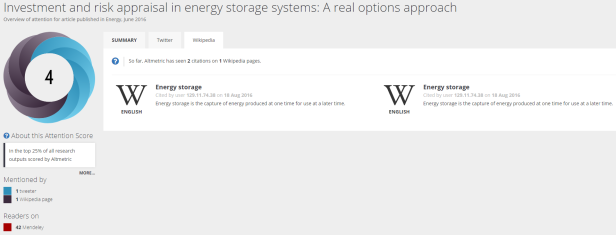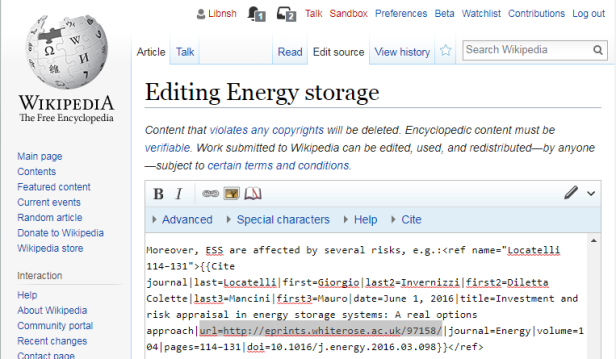In the 1980s my parents invested in an edition of the Encyclopædia Britannica. It’s still there, taking up shelf space in its burgundy livery, unopened since 1993, the information frozen in time like Britpop and New Labour.
SEWilco (Own work) [GFDL, CC-BY-SA-3.0 or CC BY-SA 2.5-2.0-1.0], via Wikimedia Commons
Wikipedia was launched in 2001, some 12 years after Berniers-Lee invented the Web, and is often maligned in academia. Yet it remains a default information source for many a denizen of the Web, whether layperson, undergraduate or PhD (citation needed).
Unlike a leather-bound Britannica, information is dynamic, updated by a small army of volunteers and there can be little argument regarding the success of the project in terms of sheer scale and cultural impact. Wikipedia and its sister projects are edited at the rate of 10 edits per second (which would equate to more than three-quarters of a billion updates since 1993. That’s a lot of crossings out.)
Whether all those edits are accurate and properly referenced is a moot point of course, and like any informational resource, digital or otherwise, requires its readership to exercise its critical faculties.
Information and digital literacy
“Information Literacy is an umbrella term which encompasses concepts such as digital, visual and media literacies, academic literacy, information handling, information skills, data curation and data management” SCONUL Working Group on Information Literacy 2011
Cognitive bias is universal, no less so in an information environment mediated by search engine algorithm, which is why peer review is essential in scholarship. Wikipedia’s model of collaborative authorship arguably provides a form of peer review and also supports formal academic citation, with many articles referencing peer reviewed sources, often by DOI. However, we are still a long way from full open access and many such references will inevitably be behind a paywall, inaccessible to those without access to a subscription through a university library i.e. those laypeople who might benefit most.
Fortunately it is quick and easy to sign up for a Wikipedia account and add a link to an open access version, in the White Rose Research Repository for example. WRRO also displays a colour coded Altmetric score to help identify when an article has been cited in Wikipedia – look out for dark grey in the patented donut:

Above is the altmetric page for Investment and risk appraisal in energy storage systems: A real options approach (DOI: 10.1016/j.energy.2016.03.098) which is linked to from a Wikipedia page on Energy Storage and which took just a few moments to edit the linked title from the published version to the WRRO record (the link to the version of record is maintained via the DOI; click on the image to see the citation on Wikipedia):

To what extent the casual visitor will actually consult a citation and follow a link to a peer reviewed source is another question. Nevertheless, the very act of contributing to Wikipedia in this way will help to embed information literate practice into this culturally significant informational resource. It also extends the network of open scholarship which, in turn, will subtly influence those search engine algorithms.
A single link perhaps not so much, but three quarters of a billion…
For more information on contributing to Wikipedia and Open Access see Wikipedia:WikiProject Open Access


hiya!
is this something you’re doing at leeds now? are you pro-actively looking for wikipedia entries to edit? i’d be interested to hear about how you’re doing that if so.
LikeLike
Hi Steve – sorry for delay, blog is relatively new and only belatedly spotted your comment! I wouldn’t say particularly proactive, just if I spot a Wikipedia score via altmetric (which I am in the habit of checking proactively). Would be much easier with Altmetric for Institutions…which we don’t subscribe to. That’s how they do it at Strathclyde I think – http://strathoa.tumblr.com/post/163709145420/contributing-to-wikicite-and-promoting-better
(Brief discussion with George McGregor on Twitter – https://twitter.com/g3om4c/status/892692491031457792)
LikeLike
Thanks for an interesting post. A few minor corrections:
The total edit count on Wikimedia projects is 3.2 billion, not three quarters of a billion. https://tools.wmflabs.org/wmcounter/
It’s known that Wikipedia articles are responsible for a significant proportion of views of DOI links:
https://www.crossref.org/blog/https-and-wikipedia/
On the Wikimedia UK Expert Outreach portal there are some great quotes from academics and academic publishers about the importance of Wikipedia in driving readers to the scholarly literature.
https://wikimedia.org.uk/wiki/Expert_outreach
It’s now possible to edit Wikipedia with a visual editor (that looks like a basic word processor): no wiki code is necessary. If you have an old account, it might be set on the wikicode editor, in which case, it can be fixed at Preferences -> Editing -> Editing mode. To cite a DOI in the visual editor, just click Cite, then paste the DOI into the tab marked Automatic.
Happy editing!
LikeLike
Also see initiative at Strathclyde – Contributing to WikiCite and promoting better exposure of repository outputs – http://strathoa.tumblr.com/post/163709145420/contributing-to-wikicite-and-promoting-better
LikeLike
I appear to have been flagged as potential spam when updating references pointing at publisher URLs to point instead at the authors’ accepted manuscript in the White Rose Repository so this is a quick overview of green open access to reassure other editors of the legitimacy of this activity, that it does not contravene copyright for example. Thank you to Jonz and PaleoNeonate for raising the issue. I will also include this information on my own talk page.
‘Green’ open access means publishing in any journal and then self-archiving a version of the article (subject to copyright transfer agreement) in an institutional repository. SHERPA/RoMEO provides details of journals that support Green Open Access and any embargo periods.
Historically, academic publishing has been based on a subscription model whereby University Libraries pay commercial publishers to access journal articles so students and staff affiliated with the University can log-in via Library systems to read the scholarly material they need for their learning, teaching and research. Those with no subscription access, outside the ivory tower, will be faced with a ‘paywall’. A typical charge to access a single journal article is $25 – $50 USD (N.B. Even the wealthiest academic libraries can afford to subscribe to only a small proportion of published scholarly output.)
This model of academic publishing dates back to the pre-internet age when the costs associated with printing and disseminating journals were far greater than today and has been criticised for enabling excessive profits for commercial publishers.
Since Stevan Harnad’s ‘subversive proposal’ in 1994 it has become commonplace for academic authors to ‘self-archive’ a version of their work in their institutional repository which publishers explicitly permit under the terms of their copyright – they generally stipulate that authors may not use the published, fully type-set version of record, only the authors’ ‘post-print’ i.e. their final accepted manuscript which has been accepted for publication and undergone peer review but has not yet had the publisher’s layout and typesetting applied. In addition and embargo may apply. Use the SHERPA/ROMEO database to identify publisher and journal specific permissions.
To use the specific article in this instance as an example:
Dodd, Matthew S., Papineau, Dominic, Grenne, Tor, Slack, John F., Rittner, Martin, Pirajno, Franco, O’Neil, Jonathan, Little, Crispin T. S. (2 March 2017). “Evidence for early life in Earth’s oldest hydrothermal vent precipitates”. Nature. 343. doi:10.1038/nature21377
This paper was published on 1st March 2017; the manuscript had been uploaded to the White Rose Repository by the Leeds based author on 10th February but was subject to a 6 month embargo under the journals standard terms (http://www.sherpa.ac.uk/romeo/search.php?issn=0028-0836)
As revealed by the altmetric score (on the repository record, click View details on Altmetric’s website the article is cited on 14 different Wikipedia pages where both the title and the DOI point to the version of record which is inaccessible without a subscription to Nature.)
When the manuscript was released from embargo in September I updated the linked titles across Wikipedia to point to the publicly accessible version instead of the paywalled version such that an interested layperson is able to access the original research in full.
Note that all references still include the linked DOI which points to the version of record.
LikeLike
Reblogged this on Amanda Panda (Duh) and commented:
On Wikipedia and Open Access (bookmarking here to find later).
LikeLike